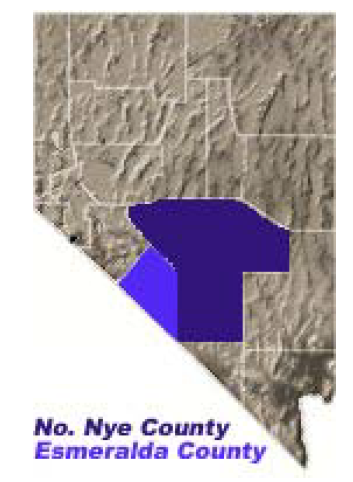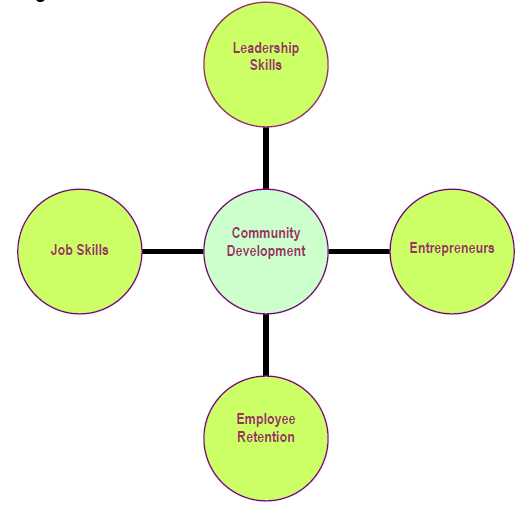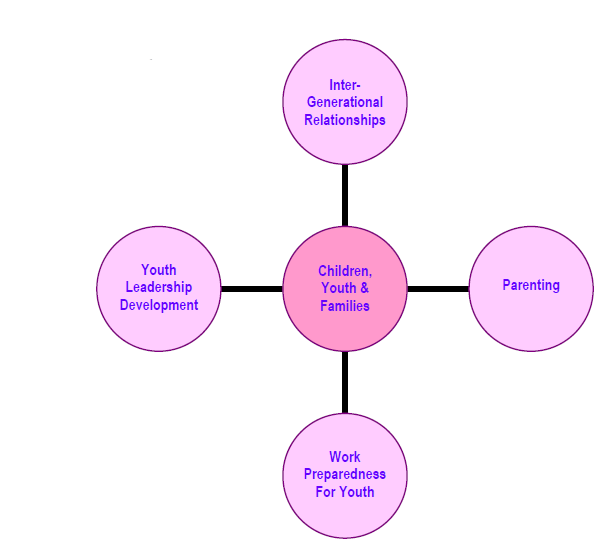Introduction
Nye and Esmeralda counties are located in central Nevada and together cover 21, 748 square miles (Census Bureau, 2006). See Figure 1. The Nevada State Demographer estimates that 46, 057 people live in this area, 2,600 of which reside in Tonopah, the largest community in Northern Nye or Esmeralda counties and the Nye County seat (State of Nevada Demographer, 2006). Other communities include Duckwater and Yomba Shoshone Indian Reservations, Belmont, Fishlake Valley, Gabbs, Goldfield, Manhattan, Round Mountain and Silver Peak. Most of these communities, including Tonopah, endure a boom-bust economy that is greatly influenced by mining and developments on the Tonopah Test Range. Beef cattle and alfalfa are also important agricultural industries in the area.
Figure 1

Community Situational Analysis
In 2006, the Extension educator for Northern Nye and Esmeralda counties conducted a community situational analysis (CSA) with the goal of identifying specific educational and research priorities. CSAs address critical needs in communities by helping highlight assets as well as needs, and providing information that will prevent duplication while filling gaps(Singletary, L. et al., 2004). CSAs can incorporate both primary and secondary data.
Methodology
Secondary data was collected from published reports, websites and conference proceedings. In addition, secondary data gathered from presentations, observations, informal conversations and meetings contributed to this CSA. Finally, primary data was acquired from in-depth, face-to-face interviews with 20 Northern Nye and Esmeralda county community leaders.
Interviews were chosen as a form of primary data collection for several reasons. Since the Extension educator was new in the community, interviews provided a way to build trusting relationships with leaders. Additionally, face-to-face interviews allowed for opportunities to dig deeper into a topic by promoting a conversational approach, rather than a more sterile question-answer session (Kvale, 1996).
Community leaders were invited to participate because they have a breadth of local knowledge and awareness of the various assets and needs of their communities. They had been exposed to and could express the variety of perspectives that residents in their communities share. Interviewees included government officials, tribal leaders, representatives such as board members from organizations and agencies and residents from Silver Peak, Smoky Valley, Fish Lake Valley, Yomba Shoshone Indian Reservation, Gabbs, Tonopah and Round Mountain. Each interview lasted about an hour.
Implications of Educational Programs
There are many important issues in Northern Nye and Esmeralda counties to address. Unfortunately, resources are not available for all of the identified educational needs to be met by Cooperative Extension. Meeting the needs of residents requires the effort, resources and community-wide collaboration of organizations, agencies, volunteers and others. Therefore, select educational programs offered by Cooperative Extension in Northern Nye and Esmeralda counties are developed and implemented based on the results of this CSA, Extension educator areas of expertise, access to colleagues with expertise and other resources such as space, funding and volunteers.
Based on the findings of this CSA, priority program areas for Northern Nye and Esmeralda counties are:
- Community Development
- 2. Children, Youth and Families
- 3. Natural Resources
- 4. Horticulture
Community Development
Community Development rose to be the top priority educational program area. All of the interviewees indicated this as a major area of concern. In Northern Nye and Esmeralda counties, the greatest needs are in economic development and building the capacity of community leaders.
According to the Economic Development Authority for Esmeralda and Nye counties (EDEN), the per capital income in both counties is well below state and regional averages (EDEN, 2006). Unemployment rates of Nye and Esmeralda counties are 4.9% and 4.6%, respectively. Sixty percent of students in Esmeralda County are eligible for the free or reduced price lunch program. Only about 44% of residents have a high school diploma (Sierra Pacific, 2006). A majority of the working population in Northern Nye and Esmeralda counties earn money through government jobs, natural resources and mining or the leisure and hospitality industry.
As a result of current local economic conditions, Extension programs focusing directly on economic development that enable and enhance entrepreneurship, job-seeking skills and employee retention would be beneficial. Figure 2 illustrates topics to focus education programs on that support community development.
In addition, community leaders require further leadership skill development. With the aim of addressing this issue, it would be valuable to offer seminars, workshops and individual experiential learning opportunities that increase the effectiveness of leaders by teaching them strategic planning, effective meeting organization, non-violent communication, grant writing and stress management.
Figure 2

Children, Youth and Families
Children, Youth and Families is the second highest priority program area in Northern Nye and Esmeralda counties. Figure 3 illustrates important issues within this program area. Eighty percent of the interviewees expressed that strengthening families and promoting positive youth development are critical needs in their communities.
People are concerned about the safety and positive development of their youth, because they want them to become productive members of their communities. Approximately 22% and 28% of families in Nye and Esmeralda counties, respectively, are led by single parents (Kids Count, 2006). This may help explain why Extension programs that promote healthy intergenerational relationships by building better parenting skills and providing opportunities for positive interactions across generations can address a critical issue. Additionally, youth programs that help develop life skills such as decision-making, conflict resolution, job skills and financial management are priorities. Programs that offer safe spaces for youth to learn and have fun, while building their leadership capacity, are also important.
Figure 3

Natural Resources
Natural Resources emerged as the third highest priority program area to people involved in ranching or living in communities at high risk for wildfire. At a southern team meeting of the Natural Resources Conservation Service in August 2006, critical issues to address in Northern Nye and Esmeralda counties were identified. These included noxious weeds, water quantity, wildfire management, critical species protection and plant vigor and health of grazing lands. In addition to water-related issues, a 2006 survey of Nevada agriculture producers revealed noxious weed identification and control methods as one of the top five issues of concern (Singletary and Smith, 2006).
Horticulture
Horticulture rated fourth in program priority in Northern Nye and Esmeralda counties. Community leaders and other members of the public indicated that there is a need for programs that teach strategies for home gardening, yard care and landscaping in high desert climates. Both beautification and efficient use of resources in yard and garden care are of concern.
Conclusions
A CSA conducted in Northern Nye and Esmeralda counties was completed in 2006. In addition to secondary data, primary data was gathered by conducting in-depth, face-to-face interviews. Although interviews lasted about an hour, most interviewees expressed an interest in continuing the conversation and all expressed a desire to learn the findings of the study.
The results of this study provide a foundation for developing programs that meet the needs of residents of Northern Nye and Esmeralda counties. Primary program areas for research and education are Community Development and Children, Youth and Families. Secondary program areas include Natural Resources and Horticulture. Extension programs will be developed and implemented to address identified critical issues in these program areas.
References
- EDEN, 2006.
- Kids Count Databook Online. 2006.
- Kvale, S. 1996. Interviews: An introduction to qualitative research interviewing. Thousand Oaks, CA: Sage Publications, Inc.
- Sierra Pacific. 2006.
- Singletary, L. and M. Smith. 2006. Nevada Agriculture Producer Research and Educational Needs: Results of 2006 Statewide Needs Assessment. University of Nevada Cooperative Extension. EB-06-02.
- Singletary, L. et al. 2004. Conducting Community Situations Analyses: A Field Guide To Dynamic Extension Programming. University of Nevada Cooperative Extension. Education Bulletin 04-02.
- State of Nevada Demographer, Nevada Small Business Development Center. 2006.
- United States Census Bureau. 2006.
Meier, A.
2007,
Northern Nye & Esmeralda Counties: Community Situational Analysis,
Extension, University of Nevada, Reno, FS-07-27


